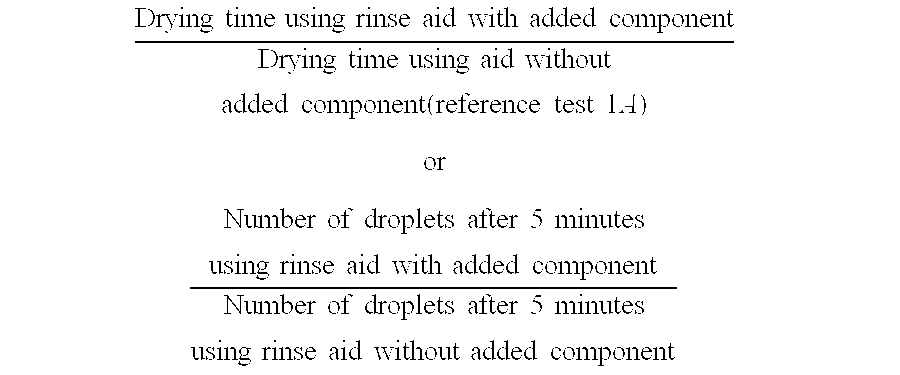Rinse aid
- Summary
- Abstract
- Description
- Claims
- Application Information
AI Technical Summary
Benefits of technology
Problems solved by technology
Method used
Image
Examples
example 2
[0150]In this example the surface tension is measured of solutions containing polysaccharides, leading to proper drying in example 1D-1G. In the same way the surface tension is measured for solutions containing standard rinse aids. These standard rinse aids, selected at random, are used both in domestic dishwash processes as in institutional dishwash processes. All these standard rinse aids contain nonionic surfactants.
[0151]Solutions from the polysaccharides are made by dissolving 1000 ppm (0.1%) in soft water by stirring for 10 minutes at 50° C. Solutions of the rinse aids are made by dissolving the standard rinse aids in soft water leading to 1000 ppm of nonionic surfactant (based on the average value given on the product ingredient declaration.
[0152]The surface tension is measured at room temperature with a bubble pressure tensiometer (KRÜSS PocketDyne). Setting are as follows: Short surface age (50-250 ms for water). Ten different measurements are done with every solution and t...
example 3
[0167]In this example the contact angle of water is measured on substrates which were contacted with solutions containing polysaccharides, leading to proper drying in example 1D-1G.
[0168]Solutions from polysaccharides are made by dissolving 1000 ppm in soft water by stirring for 10 minutes at 50° C.
[0169]Stainless steel coupons (type 304) were immersed for 20 minutes in solution of these polysaccharides at 50° C., while stirring. These coupons were rinsed for 10 seconds with softened water to remove attached solution and dried at room temperature.
[0170]Contact angles of water on these coupons were measured using an FTA 200 (First Ten Angstroms)-apparatus. The prop Shape Method was applied during the measurements.
[0171]Tested Materials Are:
[0172]3A Reference test in which coupons were immersed in water only.
[0173]Test 3B-3E are solutions containing polysaccharides, as also used in example 2.
[0174]In Table 4 the measured contact angles are given.
TABLE 4Contact angles of water on stain...
example 4
[0176]In this example the drying behaviour is tested for a liquid rinse aid containing one of the preferred polysaccharides from example 1: Jaguar® C 1000. The following polysaccharide containing rinse aid (PS-RA 1) was prepared by adding the raw materials in given order:
TABLE 5Composition PS-RA 1orderRaw material%1Soft water83%2Jaguar ® C1000 (ex Rhodia) 2%3Dequest ® 2000 (50% Amino tri (methylene 5%phosphonic acid), ex Thermphos)4Lactic acid (90%)10%
[0177]Rinse aid A (composition as in example 1) is used as reference for comparison in this test. Drying tests were carried out with the same test method as described in example 1. In this example, tap water containing 8 degrees German Hardness was applied. Furthermore, extra salt (NaCl 1000 ppm) was added to the rinse flow to create very critical drying conditions. In the main wash solution the following detergent was dosed at 0.5 g / L:
TABLE 6Liquid main wash detergentRaw material%Soft water27%Dequest ® 2000 (ex Thermphos) 2%Caustic so...
PUM
 Login to view more
Login to view more Abstract
Description
Claims
Application Information
 Login to view more
Login to view more - R&D Engineer
- R&D Manager
- IP Professional
- Industry Leading Data Capabilities
- Powerful AI technology
- Patent DNA Extraction
Browse by: Latest US Patents, China's latest patents, Technical Efficacy Thesaurus, Application Domain, Technology Topic.
© 2024 PatSnap. All rights reserved.Legal|Privacy policy|Modern Slavery Act Transparency Statement|Sitemap



